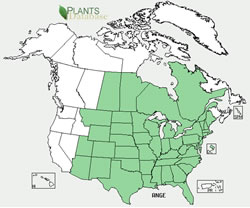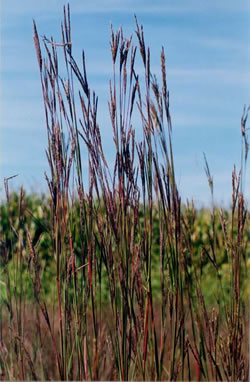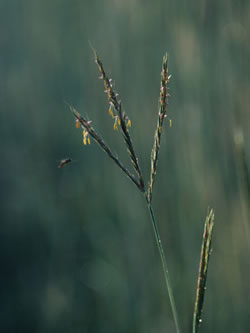Plant of the Week
 Range map of Andropogon gerardii. States are colored green where the species may be found.
Range map of Andropogon gerardii. States are colored green where the species may be found.
 Andropogon gerardii. Photos by Jennifer Anderson, USDA-NRCS PLANTS Database.
Andropogon gerardii. Photos by Jennifer Anderson, USDA-NRCS PLANTS Database.
 Flowering big bluestem and syrphid fly. Photo by Sally and Andy Wasowski, Ladybird Johnson Wildflower Center.
Flowering big bluestem and syrphid fly. Photo by Sally and Andy Wasowski, Ladybird Johnson Wildflower Center.
Big bluestem (Andropogon gerardii)
By Ryan Shurette
Big bluestem is a warm-season grass native to the eastern two thirds of the United States. It is found from the mid-western short grass prairies to the coastal plain, where it naturally serves as fuel for periodic fire. This species is large and robust as bluestems go, with mature plants commonly reaching 6 to 8 feet in height. The rhizomes are short and scaly and the color of the leaves varies from light yellow-green to burgundy. The seed head is coarse and not fluffy as in other bluestems. Individual seed heads often have three spikelets that look like a turkey foot.
“Big blue” as it is commonly called is a climax prairie species. However, it can tolerate a wide variety of well-drained soils and typically does well on low fertility sites. Big blue is commonly used in erosion control plantings; although it is sometimes slow to get started. Once it has been established, however, it provides excellent stability for sandy areas. This species is also a good native choice for grazing forage and is very palatable to livestock. As with the other bluestems, big blue also provides excellent wildlife habitat. Bobwhite quail and other ground-nesting birds use this clump-forming grass for nesting and forage cover. In the longleaf pine ecosystem, the perennial big bluestem contributes to the fine flashy fuel needed for the maintenance of the ecosystem.
Bluestem can be used in the restoration of native vegetation in agricultural or pasture areas. It is best established by conventional tillage, if possible. A native seed no-till drill may also be used. It is very important to kill all non-native pasture grasses prior to planting native warm season grasses. This is typically done using herbicides. Seeding rate for big bluestem ranges from 4 to 12 pounds per acre, depending on future use. For wildlife (quail) habitat establishment, use the lower rate. The higher rates are generally used for erosion control and grazing. Fertilizer is generally not recommended, as it typically promotes weedy competition. Several varieties of big blue are available from commercial seed producers. Try to use a local ecotype if possible when restoring native vegetation in an area.

